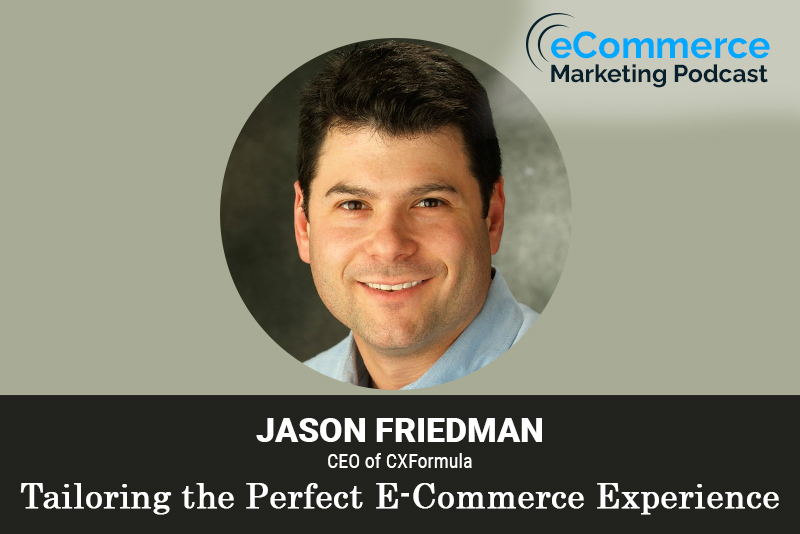
The eCommerce Marketing Podcast walks you through everything that goes into ecommerce marketing — from inbound marketing to paid advertising to conversions. Learn the strategies top marketing experts use to grow their businesses.
Head over to Leadfeeder.com and sign up for a 14-day (no strings attached) free trial!
Jason Friedman, is a serial entrepreneur who turned his passion for theater into a blueprint for business success. As CEO of CXFormula, Jason has revolutionized customer experience, applying storytelling and psychology to help companies across industries—from retail giants to financial institutions—achieve explosive growth. Recognized by Ernst and Young as Entrepreneur of the Year and leading his company to the Inc. 5000 list multiple times, Jason’s unique approach has made a significant impact. Beyond his professional accolades, he’s a proud dad and dog lover.
In this episode, you will learn
- The importance of customer journey mapping in ecommerce and how it can be effectively implemented to enhance the customer experience
- How critical personalization is in ecommerce settings, and strategies for creating more personalized customer experiences
- What role does customer feedback play in shaping the customer experience, and what are some effective ways for businesses to collect and act on this feedback
- How emerging technologies like AI and VR are changing the landscape of customer experience in ecommerce over the next few years
- The biggest trends and changes in ecommerce customer experience that are coming within the next decade
For show transcript and past guests, please visit https://www.ecommercemarketingpodcast.com
Or on YouTube at:
https://www.youtube.com/channel/UC3PgT0NOGzpdPGQtBK0XLIQ
Follow Arlen:
Twitter: https://twitter.com/askarlen
Facebook: https://www.facebook.com/arlen.robinson.7
Instagram: https://www.instagram.com/arlenyohance/
LinkedIn: https://www.linkedin.com/in/arlenrobinson/
Past guests on the ecommerce marketing podcast include Neil Patel, Nemo Chu, Luke Lintz, Luke Carthy, Amber Armstrong, Kris Ruby and many more.
Thanks for listening. Be sure to subscribe and leave a review.

In this episode of the E-Commerce Marketing Podcast, host Arlen Robinson interviews Jason Friedman, the CEO of CX Formula. Jason shares his journey from theater to becoming an expert in customer experience, helping companies achieve growth through storytelling and psychology. Jason discusses how businesses can create exceptional customer experiences to drive loyalty and growth.
Key Takeaways
- Introduction and Background ([00:02] – [03:49])
- Jason’s transition from theater and rock concerts to customer experience.
- How his background in theater helped him understand customer engagement.
- Understanding Customer Experience ([03:49] – [06:57])
- Experience is how customers feel about their interactions with your brand.
- Importance of mapping the customer journey from the customer’s perspective.
- Journey Mapping for E-Commerce Brands ([06:57] – [09:28])
- Begin mapping the journey from the moment customers identify a need.
- Map beyond the purchase to include usage and potential repeat purchases.
- Personalizing Customer Experience ([09:28] – [14:35])
- Use mass customization to tailor experiences for different customer avatars.
- Map the journey for each avatar and identify key moments for personalization.
- Importance of Customer Feedback ([14:35] – [21:09])
- Feedback is crucial for understanding and improving the customer journey.
- Investigate complaints thoroughly and make necessary adjustments.
- Handling Customer Complaints ([21:09] – [28:29])
- Address issues promptly and with empathy to build deeper customer relationships.
- Example of a company handling a product issue with grace and improving customer loyalty.
- Future Trends in E-Commerce Customer Experience ([28:29] – [31:04])
- Increasing use of AI and technology for personalization.
- Human interaction remains essential for building lasting customer relationships.
- Jason’s Philosophy and Current Focus ([31:04] – [34:00])
- Retirement as the freedom to choose what you do every day.
- Passion for helping entrepreneurs create better customer experiences.
Guest Info
Jason Friedman
CEO of CX Formula
Website: CX Formula
Special Gift: CX Formula Gift











